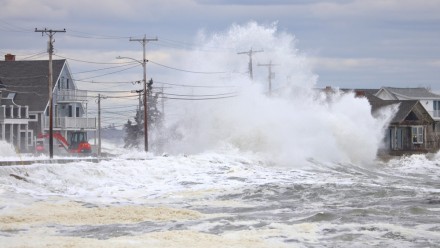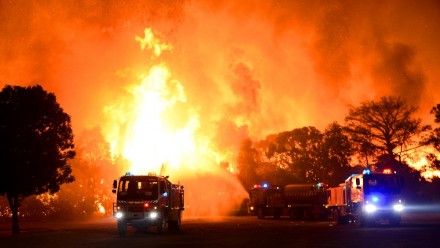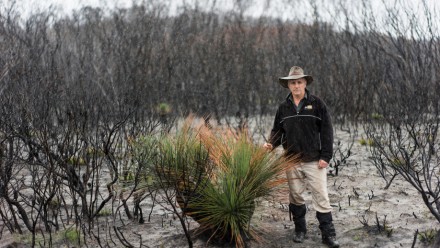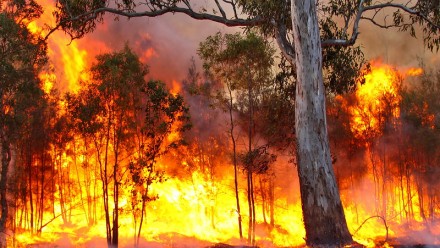Disaster solutions 2021

Disaster solutions overview
As extreme weather events such as droughts, floods, cyclones and heatwaves increase and intensify as a result of climate change, so too does the focus on ways to predict, prevent and mitigate the impacts of these events. Throughout 2021, ANU researchers made vital contributions to developing innovative solutions to disasters. With particular focus on bushfire prevention, storm protection, floods, and health, this work has built strong partnerships and networks across many sectors of government, industry and community.
The ANU/Optus Bushfire Research Centre for Excellence is focussed on evaluating a series of technologies for early detection of bushfire ignitions, with a goal of preventing catastrophic bushfires through early detection and rapid extinguishing. In 2021, the Centre commenced research to develop new drone technology to provide rapid validation of lightning strike ignitions in deep bushland, which are responsible for the majority of catastrophic bushfires. Engaging with Australian drone manufacturer, Carbonix, the project placed ANU research and development at the centre of this important field.
Research and news
7 Jan 2022
Research led by Professor Robert Costanza has shown that coastal wetlands are both a successful and cost-effective method of preventing storm damages.
7 Jan 2022
New research is investigating innovative options to combat and prevent catastrophic bushfires using drones.
26 Oct 2021
Four ANU experts warn that Pacific nations are at risk of being left behind in global climate negotiations if they aren’t a focus of the upcoming COP26 summit...
16 Aug 2021
Logged forests near regional and rural towns and settlements are at increased risk of increased fire severity, new research from ANU shows.
21 Jul 2021
Germany has had its worst floods in a millennium. Record-breaking heat baked western Canada. California is ablaze yet again. Eastern Australia is still...
21 Jun 2021
Pregnant women exposed to natural disasters such as volcanoes are more likely to give birth prematurely, according to a new study from The Australian National...
Director's highlights
Dr Roslyn Prinsley has undertaken significant stakeholder engagement in 2021 - from mapping ANU expertise networks in preparedness for and prevention of natural disasters, to creating and strengthening relationships with local and state level governments, community organisations, national agencies and industry.

In 2021, Dr Prinsley initiated an interdisciplinary project to support local Australian communities mitigate future flood risk. While still in the planning stages, the concept has received support from state and national agencies including from National Recovery and Resilience Agency, Queensland Reconstruction Authority, Murray-Darling Basing Authority, The Nature Conservancy, Floodplain Management Australia, Flood Community of Practice, Goulbourn Broken Catchment Management Authority, The Mulloon Institute, Hunter Local Land Services, Swiss Re and WaterTech. The project plans to involve rural, regional and peri-urban communities across New South Wales, Victoria and Queensland, with engagement initiated with Central Coast Council, Eurobodalla Shire Council, Moree Plains Shire Council, Warren Shire Council and Penrith City Council.
Dr Prinsley has also sought to align research priorities and strengthen relationships with various government and industry agencies, connecting them with ANU expertise related to disaster solutions. These groups include ACT Government, CSIRO, Natural Hazards Research Australia, the National Recovery and Resilience Agency, UNDRR, the Australian Local Government Association, Local Government Association SA, and Integrated Research on Disaster Risk (IRDR), of which ICEDS is an International Centre of Excellence.
Research publications

Over 300 articles related to natural disasters were published by ANU researchers in 2021 in high-profile journals including International Journal of Disaster Risk Science, Australian Journal of Emergency Management, International Journal of Environmental Research and Public Health, Natural Hazards, Frontiers in Public Health, Remote Sensing of Environment, and more.
The diverse and extensive expertise of ANU researchers working in natural disaster-related fields spans across bushfires, floods, cyclones, earthquakes, tsunamis, storms - examining each from risk, to preparedness, to solutions. Bushfire research undertaken at the University epitomises this. To date, it has included assessments of the effects of bushfire and smoke, remote sensing for forest fire fuel, policy implications and the development of an integrated system to development to protect Australia from catastrophic bushfires.
Projects and initiatives
An integrated system to protect Australia from catastrophic bushfires
The Australian National University is undertaking advanced interdisciplinary research to develop an innovative national system to detect bushfires as soon as they start and extinguish them within minutes.
In collaboration with ACT Parks and Conservation Service and the ACT Rural Fire Service, ANU has developed an integrated research initiative encompassing six programs from fire prevention to suppression as illustrated in Figure 1.

Program 1: Prevention and risk reduction aims to evaluate the effectiveness of ecological fire-risk reduction strategies and develop the next generation of fire-risk models. Australian development of the ANU OzFuel infrared smallSat mission addresses the recommendations for efficient national monitoring of fuel conditions, which are common to independent national and state inquiries while complementing national and international missions dedicated to rapid fire detection. This is the first step towards a coordinated effort to monitor eucalypt fuel conditions from space.
Program 2: Lightning forecasting and detection aims to develop capacity to rapidly identify which lightning strikes within an individual storm are most likely to cause an ignition. This allows for faster responses to fire detection and suppression.
Program 3: Ignition detection is the core work being done by the ANU-Optus Bushfire Research Centre of Excellence, which is developing an optimised, integrated, layered, hi-tech solution to detect small fires.
Program 4: Data analytics and communications aims to create actionable intelligence by integrating high-resolution fuel availability information into the ANU FirePrep decision-support tool.
Program 5: Safe and rapid suppression addresses the need to rapidly extinguish ignitions by developing an innovative suppression vehicle.
Program 6: Legal and economic analysis includes laws and regulations on surveillance and listening devices, privacy and telecommunications.
More information about the ANU/Optus Bushfire Centre of Excellence can be found on the ANU website.
Partnering with local communities in regional Australia to increase resilience to flood risks
Australia is very exposed to damage caused by extreme rainfall. The challenges of flood risk management are being compounded by climate change, which is bringing increased severity and frequency of extreme weather events. This increases the risk to people, infrastructure, agriculture and ecosystems. Most recently in Australia, parts of New South Wales and Queensland were hit by severe flooding in January 2022 and March 2021, resulting in overflowing rivers and dams, and destroyed homes. Conventional flood risk management systems involving engineering measures, such as building embankments or channels, have prevented damage to life and property. However, in some cases, they have also led to perverse outcomes and risks such as incentivized development behind levees (the “levee paradox”), they are subject to catastrophic failure, and they have resulted in a loss of natural habitat and ecosystem services.

In 2021, ICEDS assembled an experienced team of researchers across water science, ecology, economics, social science, engineering, policy and modelling. The group is planning to partner with rural, regional and peri-urban communities in a range of regional locations across New South Wales, Queensland and Victoria, to assess and quantify options for increasing community resilience to inland and coastal river flooding, with the aim of improving the understanding of flood risk and the options for increasing resilience to floods in communities across the country.
The group is signing up a multi-stakeholder Advisory Committee, to ensure that learnings from all levels of government, relevant industry sectors and professional associations are incorporated into the project’s framework. Further updates on the project will be provided throughout 2022.
Measuring the impact of bushfires on mothers and children
Led by Dr Christopher Nolan, MC2020 is a population-based study of 1055 mother-child pairs in the ACT & south east New South Wales (NSW), one of the regions worst affected by the 2019/20 Australian bushfires. MC2020 looks at the effects of prolonged smoke exposure, fire, evacuation and personal loss (lives, housing, livelihood, sacred sites, cultural lands) on the health and wellbeing of mothers and their babies. Through a series of on-line surveys and interviews, the interdisciplinary study team is exploring the experiences of mothers who were either soon to conceive, pregnant or a mother of a newborn during the 2019/20 bushfires.

- One third reside in south-NSW (one of most severely impacted regions by the 2019/20 fires) and two-thirds in the ACT (most severely affected by bushfire smoke).
- On the 1st February 2020, 24% were mothers of an infant < 3 months of age, 27% were in the third trimester of pregnancy, 42% were in the 1st or 2nd trimester of pregnancy and 7% were not pregnant, but conceived before the 30th April.
- Severe and moderate smoke exposure was reported in 64% and 30% of the women, respectively.
- The bushfires were followed by the COVID-19 crisis. All MC2020 mothers and babies experienced community lockdowns and altered access to health care and usual support from family and friends.
The stories provided by participating mothers are rich and insightful. Some key findings include:
- Many experienced high levels of stress as a consequence of the bushfire smoke, being concerned for its potential harmful effects on their unborn or newborn baby, as well as their other children.
- Most commented on the lack of information available on the risks of the smoke to their pregnancy or recently born baby and the best steps to mitigate these risk.
- Evacuation centres were not friendly to new mothers (e.g. lack of privacy breast-feeding)
- Many mothers experienced disruptions to their pregnancy and post-natal care, later compounded by the COVID19 restrictions (often made worse by COVID-19 restrictions).
- Usual social support networks that are critical to the wellbeing of new mothers were disrupted over this period for many of the women.
Researchers are feeding back to communities, government and health services that there is a need for:
- Time and place specific air-quality information and advice.
- More detailed information about the effects of smoke exposure on infants and pregnant mothers and advice about what to do.
- Better planning for future bushfire/smoke events to ensure less disruption of maternal and infant care services.
You can read more about the MC2020 project, here.
Workshops on the Royal Commission into National Natural Disaster Arrangements
Following the Australian Black Summer bushfires, The Royal Commission into National Natural Disaster Arrangements (RC NNDA) was formed to examine how prepared Australia is to respond to bushfires and other natural disasters.
From 20 May to 18 June 2021, the ANU Institute for Climate, Energy & Disaster Solutions facilitated a series of targeted online workshops to discuss how government, industry and society can go about the challenge of implementing the Bushfire Royal Commission’s wide-ranging recommendations.
The following is a summary of these workshops (with exception of Workshop 3 which was not recorded).

Photo: Jamie Kidston/ANU Media
Workshop #1 - Managing bushfire risk in the landscape
Protecting people and assets – the environment, infrastructure and property – is at the heart of bushfire risk management strategies. Managing disaster risk is, as the RC NNDA noted, “inherently complex”.
In this forum, Prof Phil Gibbons (Fenner School of Environment and Society) and Dr Richard Thornton (Chief Executive Officer, Bushfire and Natural Hazards CRC) addressed recent research and contemporary thinking about bushfire risk management in the landscape.
Watch the video of the discussion here.
Workshop #2 - Emerging technologies and bushfires: realising the promise
The RC NNDA identified investment in emerging technologies as one of the areas of promise and priority that Australia was well-placed to develop further.
In this panel, Assoc Prof Marta Yebra and Prof Rob Mahony outlined their work on developing technologies for early fire detection and response; and Dr Tony Bartlett reflects on the history of technology development in bushfire suppression, and what it suggests for future priorities.
Watch the video of the discussion here.
Workshop #4 - Health and Disasters: A Hypothetical Discussion
The 4th workshop in the series specifically addressed the issue of Health and Disasters. Framed in a hypothetical discussion, the session featured a panel of experienced health practitioners and researchers, prompting questions and discussion about individual and community health as well as health system response centred around risk of natural disasters in our changing climate.
Watch the video of the discussion here.
Preparing electricity networks for extreme climate events: Learnings from California and Texas
In 2021, both California and Texas plunged into electricity blackouts. In California’s case, these blackouts were intentional to avoid power infrastructure sparking fires in the drought-ridden region. This is expected to keep occurring in the coming years. In the case of Texas, the blackout was due to an overloaded electricity system compromised by extreme cold weather.

As such weather events become more extreme and frequent under climate change, how can Australia learn from both these situations to avoid such blackouts here?
At this event, experts discussed what went wrong in California and Texas, and what Australia can do to increase the resilience of its own energy infrastructure and supply at this seminar.
Watch the video of the discussion here.
Anticipating extreme crises and disruptions: Developing a National Risk Management Strategy
At this ICEDS-hosted seminar, experts explored the structure of a risk management strategy and considered how it could enhance national policy development in the context of an evolving threat landscape.
Discussion focused on the importance of engagement of society and government with science - informed by a national risk management strategy - that recognises the benefits of collaborative thinking and generation of insight into the dynamics of natural and sociotechnical threats. Watch the video of the discussion here.
Member highlights
The following section comprises of contributions from a selection of ICEDS members working in varied aspects of disasters. It highlights their activity in relation to public policy engagement and outreach in 2021.
Associate Professor Chris Ballard
Associate Professor Chris Ballard’s work focuses on the relationship between culture and cultural heritage and disasters, emergencies and climate change, with a focus on the Asia Pacific region; a current research project addresses the 15th C VEI7 eruption of Kuwae in Vanuatu, and its local, regional and global consequences.
In 2021, Professor Ballard was engaged in the following activity:
Research
-
Chief Investigator (with CI Stuart Bedford), ARC Discovery Grant, Kuwae 1452 AD: multi-disciplinary perspectives on a Pacific super-eruption.
-
Sebak Saha and Chris Ballard 2021. ‘Cyclone Aila and post-disaster housing assistance in Bangladesh.’ Sustainability 13, 8604.
-
Kelsie Long, Larissa Schneider, Simon Connor, Niamh Shulmeister, Janet Finn, Georgia Roberts, Atun Zawadiszki, T. Gabriel Enge, John P. Smol, Chris Ballard, Simon G. Haberle 2021. ‘Human impacts and Anthropocene environmental change at Lake Kutubu, a Ramsar wetland in Papua New Guinea.’ PNAS 118(40):
-
Chris Ballard 2021. ‘Transmission’s end? Cataclysm and chronology in Indigenous oral tradition.’ In Ann McGrath and Lynette Russell (eds) The Routledge Companion to Global Indigenous History. London: Routledge, pp. 571-602.
Education
-
Convenor, MA course in S2, ASIA8048, Disasters and Epidemics in Asia and the Pacific Facilitator, UNESCO Training Workshop on Intangible Cultural Heritage in Emergencies, Philippines, May-July
-
Chair Supervisor for ANU PhD thesis conferred in 2021: Sebak Saha, Social Capital and Post-Disaster Response and Recovery: Cyclone Aila in Bangladesh, 2009.
-
Chair Supervisor for ANU MA (Advanced) Asia-Pacific Studies sub-thesis conferred in 2021: Akiko Hirata, Integrating Local Knowledge into Tsunami Risk Reduction.
Public policy
-
Lead author, Joint White Paper on Cultural Heritage and Climate Change: New Challenges and Perspectives for Research, Joint Project Initiative (JPI) Climate and JPI Cultural Heritage, European Union.
-
Co-Author, White Paper 2: Impacts, Vulnerability and Understanding Risks, for International Co-Sponsored Meeting on Culture, Heritage and Climate Change, co-sponsored by United Nations Educational, Scientific and Cultural Organization (UNESCO), the International Council on Monuments and Sites (ICOMOS), and the Intergovernmental Panel on Climate Change (IPCC), in partnership with International Union for the Conservation of Nature (IUCN) and ICLEI (Local Governments for Sustainability)
-
Sole Author, Concept Note on Intangible Cultural Heritage and Climate Change, commissioned by Living Heritage Entity, UNESCO, Paris.

Dr Christopher Ballard discussed what ancient cataclysms, such as the Kuwae eruption, might have to teach us about possible responses to contemporary climate change at the ‘In Conversation’ event.
Outreach
-
Culture and the mitigation of geohazard disasters. Invited paper, 16th Regional Geoscience Congress of Southeast Asia (GEOSEA XVI), 2-8 December.
-
Stratigraphic Insights into the ~AD1450 caldera-forming Kuwae eruption sequence, central Vanuatu, South Pacific. Paper presented at Geoscience Society of New Zealand Annual Conference, University of Canterbury, Christchurch, New Zealand, 22-25 November. [Sönke Stern, Shane Cronin, Stuart Bedford, Chris Ballard, Nicola Strandberg, Sandra Nogue-Bosch and David Sear]
-
Material witnesses: the Kuwae eruption and Tongoan histories. Paper for the Symposium on Returns and Reconnections: Relationships with the Deep Past? Hosted by the Research Centre for Deep History (ANU) and the McDonald Institute for Archaeological Research (University of Cambridge), 20 September. [Ballard, Sandrine Bessis, and Alice Kaloran]
-
Academy of Humanities President’s Conversation on Climate Change and Heritage, 15 September.
-
Kuwae, and other volcanoes. Public talk, Chau Chak Wing Museum, University of Sydney, 9 September.
-
In Conversation with Christopher Ballard - The impact and story of Vanuatu's Kuwae eruption. Video interview with Helen O’Sullivan, Dean of the College of Asia and the Pacific, ANU, 22 July.
-
Partnering with UNESCO on climate change and emergencies. CHL Engagement and Impact Workshop, 30 June.
-
Disaster as opportunity: re-integrating ICH and World Heritage in the aftermath of Cyclone Pam, Vanuatu. Webinar, Session 15: “Intangible Heritage and Disasters”, “Our World Heritage – Disasters and Pandemics”, University College, London.
-
People, place and story: an integrated account of transmission (and disaster). Paper for session Ends of Oblivion: Continuities and Discontinuities in Oceania's Pasts, ASAO Conference, 6 February.
Professor. Phil Cummins
During 2021 Professor. Phil Cummins continued research on earthquake and tsunami hazards in the Asia-Pacific region, including collaboration with Bandung Institute of Technology in Indonesia, and supervision of five PhD students. The students are undertaking research on historical earthquakes in Australia, Indonesia and Papua New Guinea, urban seismic risk in Java, Indonesia, and the effect of crustal velocity structure in amplifying earthquake ground motion in Indonesia. His work with Geoscience Australia has also involved improvement in tsunami hazard assessment methodology.

Photo: Shutterstock
Publications
- Rosalia S, Wei S, Widiyantoro S, Cummins PR, Muzli M, Sahara DP, Puspito NT, Priyono A and Afif H (2021). Delineation of Upper Crustal Structure Beneath the Island of Lombok, Indonesia, Using Ambient Seismic Noise Tomography. Front. Earth Sci. 9:560428.
- Pranantyo, Ignatius R; Heidarzadeh, Mohammad; Cummins, Phil R. (2021). Complex tsunami hazards in eastern Indonesia from seismic and non-seismic sources: Deterministic modelling based on historical and modern data, Geoscience Letters 8:20.
- Rafie MT, Cummins PR, Sahara DP, Widiyantoro S, Triyoso W and Nugraha AD (2021) Variations in Forearc Stress and Changes in Principle Stress Orientations Caused by the 2004–2005 Megathrust Earthquakes in Sumatra, Indonesia. Front. Earth Sci. 9:712144.
- Sarjan AFN, Zulfakriza Z, Nugraha AD, Rosalia S, Wei S, Widiyantoro S, Cummins PR, Muzli M, Sahara DP, Puspito NT, Priyono A and Afif H (2021) Delineation of Upper Crustal Structure Beneath the Island of Lombok, Indonesia, Using Ambient Seismic Noise Tomography. Front. Earth Sci. 9:560428.
- Davies, Gareth; Weber, Rikki; Wilson, Kaya; Cummins, Phil (2021). From offshore to onshore probabilistic tsunami hazard assessment via efficient Monte-Carlo sampling 2021, EarthArXiv
Professor Vladimir Canudas Romo
Professor Vladimir Canudas Romo co-authored a paper on Mortality attributable to fine particulate matter in Asia, 2000–2015: a cross-sectional cause-of-death analysis.
John Reid

As part of OUTPUT Art after Fire (a pilot project funded by the Department of Foreign Affairs and Trade), John Reid established FieldScreen International. The project aimed to recruit creative artists experienced in field research who could mentor other artists in Southeast Australia and West United States affected by 2019-20 fires, and who would appreciate collegial engagement to re-establish creative practice.
The evaluation report of the pilot project has substantially reconfigured methodology for remote/online creative art mentoring, especially with disaster traumatised artist participants. Funding for a more expansive project is currently being sought by FieldScreen International in collaboration with South East Arts and the Blue Mountains City Council.
Artists involved in OUTPUT Art after Fire produced new work for potential exhibition in respective communities as a trauma recovery measure. The project folio, OUTPUT Art after Fire: A Folio, a project output, presents a selection of artwork that can be viewed at: https://www.artafterfire.com.au/













